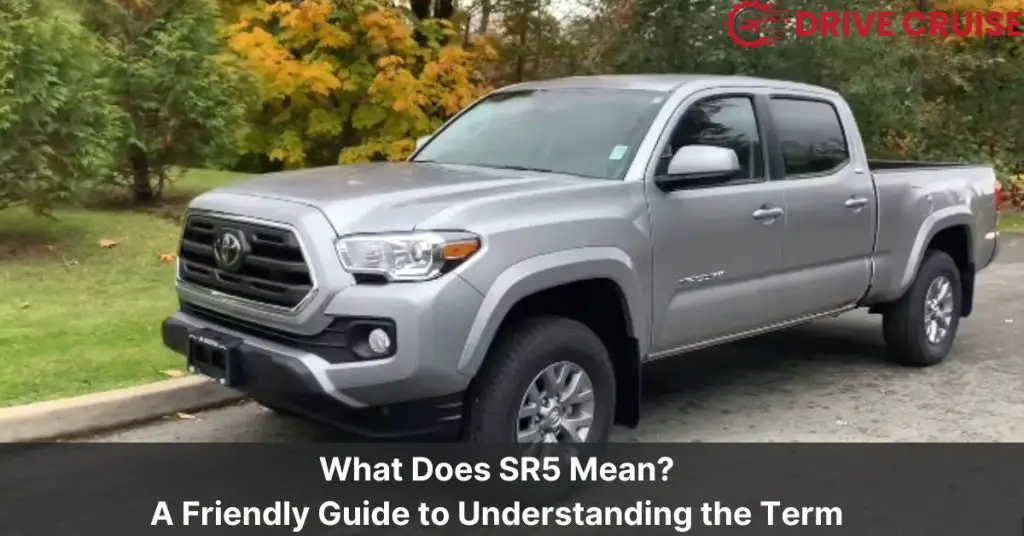Encountering the designation “SR5” on a Toyota or Lexus vehicle can spark curiosity. You might be wondering what it means and if it has any significance. The truth is, the meaning of “SR5” can vary depending on the model and era.
If you’re a car enthusiast or potential buyer, understanding the history and evolution of “SR5” can be valuable information. It can help you better understand the features and capabilities of the vehicle you’re interested in. In this guide, we’ll explore what “SR5” means on Toyota and Lexus vehicles, and how it has evolved over time.
The Original “SR5”: A Legacy of Sport and Utility (Toyota)
If you’re a fan of Toyota trucks and SUVs, you’ve probably heard of the SR5 trim level. But what does “SR5” actually mean? Let’s take a closer look at this iconic designation.
Debuting in the 1980s: Trucks and SUVs Take Center Stage
The “SR5” designation first appeared on Toyota trucks and SUVs in the 1980s. It signified a step above the base model, offering a sportier look and enhanced features. This was a time when trucks and SUVs were becoming more popular, and Toyota wanted to appeal to buyers looking for a vehicle that was both sporty and practical.
Beyond the Basics: Ausstattung that Elevated the Driving Experience (German for “Equipment”)
Early SR5 models typically included features like bucket seats, an upgraded suspension for improved handling, alloy wheels, and sporty exterior graphics (on some models). These features helped to set the SR5 apart from the base model, giving it a more aggressive and athletic look.
Not Just Performance: Utility Enhancements for Active Lifestyles
But “SR5” didn’t solely focus on sportiness. Some models offered features like sunroofs, roof racks, and towing packages. These features were designed to appeal to buyers with active lifestyles, who needed a vehicle that was not only sporty but also practical and versatile.
SR5 Today: A Designation in Transition (Toyota & Lexus)
Diversification Across Brands: Toyota and the Introduction of Lexus
With the introduction of the Lexus brand in the late 1980s, some Toyota models with the “SR5” designation became Lexus offerings. The Toyota 4Runner, for example, was available in an SR5 trim level from 1984 to 2002. When the Lexus GX was introduced in 2002, it included an SR5 trim level as well. The Toyota Tacoma has also had an SR5 trim level since the 1980s, and it is still available today.
Modern Interpretation: Sportier Aesthetics Take Precedence (Especially Lexus)
On modern Lexus models, “SR5” often signifies a sportier appearance package, including unique wheels, upgraded upholstery, and a sport-tuned suspension on some models. This is especially true for the Lexus IS and GS sedans, which feature an SR5 F Sport package. The F Sport package includes more aggressive styling, sport-tuned suspension, and other performance enhancements.
Toyota: Inconsistent Use and Potential Retirement
The use of “SR5” on current Toyota models is less consistent. It might denote a mid-tier trim level on some trucks or SUVs, while being absent on others. For example, the Toyota Tundra has an SR5 trim level that is one step up from the base SR trim, while the Toyota RAV4 does not have an SR5 trim level at all. There’s speculation that Toyota might eventually phase out the designation altogether, as it has already done with some other trim levels, such as the XSE on the Camry and Avalon.
Beyond the Badge: Understanding What Matters Most
When considering a Toyota or Lexus with the “SR5” badge, it’s important to remember that the badge itself is just a small part of the overall package. Here are some tips to help you focus on what really matters when evaluating a vehicle with the “SR5” designation.
Focus on Features and Functionality Over Legacy
While the history of “SR5” is interesting, it’s important to remember that the badge itself doesn’t necessarily guarantee a particular set of features or capabilities. Instead, focus on the specific features and functionality that are most important to you when evaluating a particular vehicle. For example, if you’re looking for a truck that can handle off-road terrain, look for features like skid plates, locking rear differentials, and high ground clearance.
Research Specific Models and Trim Levels
When considering a Toyota or Lexus with “SR5,” it’s important to remember that the specific features and capabilities can vary depending on the model year and trim level. For example, the “SR5” package on a Toyota Tacoma may offer different features than the “SR5” package on a Toyota Tundra. Be sure to research the specific model and trim level you’re interested in to get a clear understanding of the features and performance characteristics it offers.
Consult Reviews and Expert Opinions
In addition to your own research, it can be helpful to consult online resources, car reviews, and automotive specialists to gain a comprehensive understanding of a specific “SR5” model before making a purchase decision. Look for reviews and opinions from trusted sources to get a well-rounded perspective on the vehicle you’re considering.
Conclusion: Demystifying SR5 – Knowledge Empowers Choice
Now that you have read about the history and various interpretations of the “SR5” badge on Toyota and Lexus vehicles, you are better equipped to make an informed decision when it comes to choosing a car that fits your needs and driving style.
It is important to note that the “SR5” badge does not necessarily guarantee a specific set of features or functionality. Instead, it is more of a trim level designation that can vary depending on the specific model and year of the vehicle.
When considering a car with the “SR5” badge, take the time to research the specific features and options that come with that particular trim level. This will help you determine if it aligns with your needs and preferences.
Related Posts:







